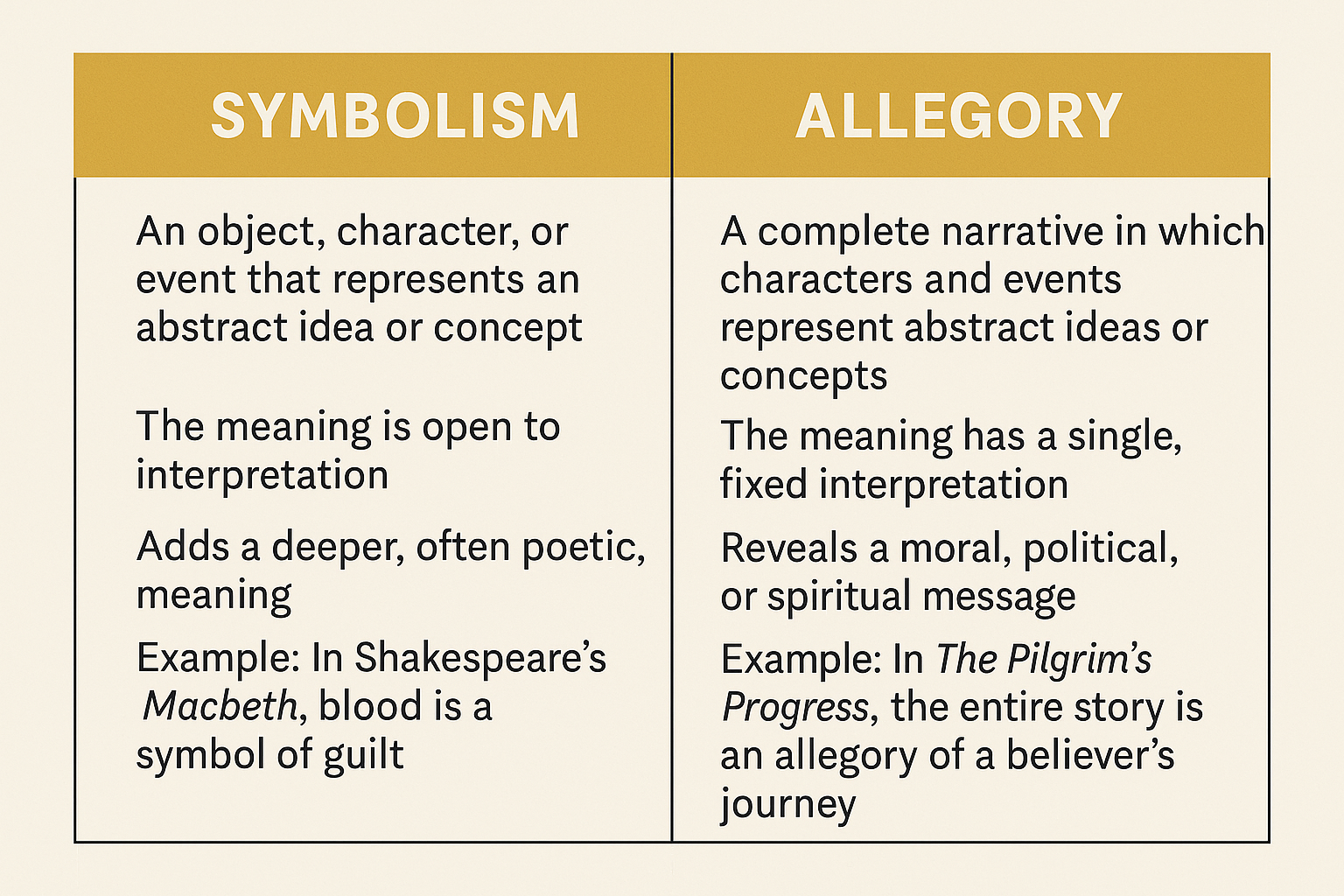Introduction
In literature, both symbolism and allegory are powerful tools writers use to add depth to their stories. Although they may seem similar, they are actually quite different in how they work and what they achieve. Understanding the difference between symbolism and allegory can help readers grasp deeper meanings in poems, novels, and plays.
What Is Symbolism?
Symbolism is the use of an object, character, color, or event to represent a deeper idea or concept. It allows one thing to stand for another. For example, a rose may symbolize love, a storm may symbolize chaos, or a journey may symbolize personal growth. These meanings are not stated directly. Instead, the reader must interpret them based on the context of the story.
Writers use symbols to suggest layers of meaning without having to explain them directly. A symbol can be open-ended. It may carry different meanings for different readers or be interpreted in more than one way. Because of this, symbolism creates richness and mystery in literature.
What Is Allegory?
On the other hand, allegory is a complete narrative in which every character, event, or setting stands for something else. It is more structured and planned than symbolism. In an allegory, the entire story works as a metaphor for a larger moral, political, or spiritual message. Unlike symbols, allegories have clear and fixed meanings.
For example, Animal Farm by George Orwell is a political allegory. The animals represent real political figures and ideologies from the Russian Revolution. Each character and event directly matches a real-world counterpart. The story may seem simple on the surface, but it clearly delivers a deeper message about power and corruption.
Key Differences Between Symbolism and Allegory
1. Scope and Structure
Symbolism can appear in a single line, sentence, or scene. It is often used here and there throughout a story. In contrast, an allegory is usually the structure of the entire story. Every part of it carries symbolic meaning.
2. Flexibility of Meaning
Symbols can be vague and open to interpretation. One reader might see a snake as a symbol of evil. Another may see it as a symbol of transformation. Allegories, however, are more direct. They follow a planned system where each part of the story has a set meaning.
3. Purpose
Writers use symbolism to deepen emotional or philosophical meaning. It enriches the reading experience without explaining too much. Allegory, on the other hand, is often used to teach a lesson or express a clear message. It is more about revealing a truth than creating beauty or mood.
4. Reader Engagement
When readers come across a symbol, they must think and analyze to understand what it might mean. This process is subjective. But with allegory, the author leads the reader toward one fixed interpretation. Therefore, allegory is more didactic, while symbolism is more poetic.
Examples to Understand Better
- Symbolism: In Shakespeare’s Macbeth, blood symbolizes guilt. It appears many times in the play, each time reminding the audience of the characters’ moral downfall.
- Allegory: In The Pilgrim’s Progress by John Bunyan, the character named Christian travels through several symbolic places. He journeys through locations such as the Slough of Despond. He also visits Vanity Fair. These are not real places but symbols of the challenges and temptations faced by believers.
Final Thoughts
To sum up, both symbolism and allegory deal with hidden meanings, but they work in different ways. Symbolism uses one thing to suggest another and can be open to many meanings. Allegory, however, uses the whole story to teach a specific idea, and each element has a clear meaning.
Understanding the difference between symbolism and allegory helps readers better appreciate literature. It allows them to notice the writer’s techniques. They can uncover the layers of meaning hidden beneath the surface of the text.

Allegory in Literature:https://englishlitnotes.com/2025/06/22/allegory-in-literature/
Jack London and Naturalism: https://americanlit.englishlitnotes.com/jack-london-and-naturalism/
Use of Since and For in English: https://grammarpuzzlesolved.englishlitnotes.com/since-and-for-in-english-grammar/
The Foolish Stag: https://englishwithnaeemullahbutt.com/2025/05/01/the-foolish-stag/
Discover more from Naeem Ullah Butt - Mr.Blogger
Subscribe to get the latest posts sent to your email.
